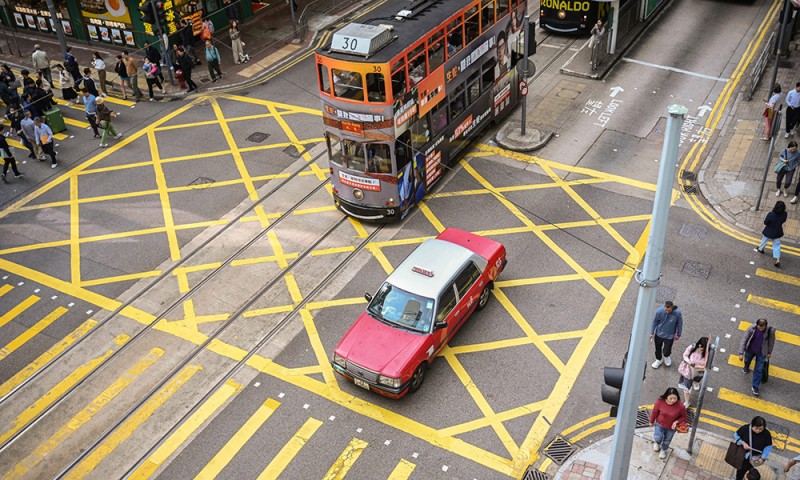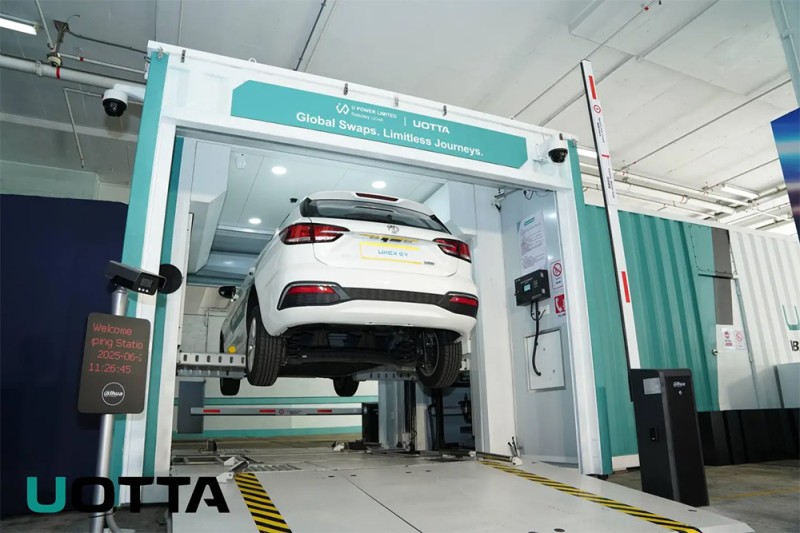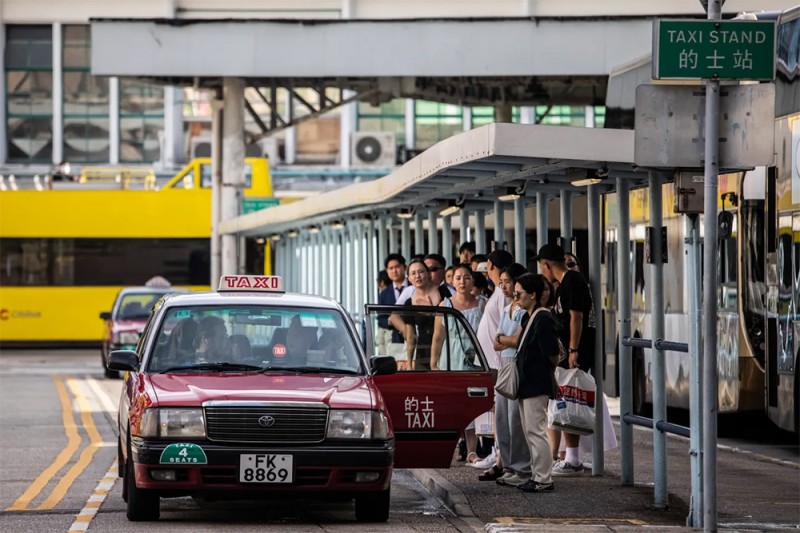
最近的一个早晨,在香港繁忙的货运码头附近的一个工业区,一辆白色名爵(MG)电动出租车缓缓驶入了一个类似洗车房的狭窄换电柜。液压升降装置将车辆托起,引导式机械系统随即滑出出租车耗尽的电池,并换上充满电的新电池。整个过程无需插电,也无需坐等充电。不到三分钟,出租车即可重新上路。这是优品车(U Power)在香港投放的首个换电柜。这家鲜为人知的初创公司来自上海,计划在香港建设数百个换电柜,致力于让以老旧过时闻名的香港出租车车队的核心系统实现电动化。
这个市场存在巨大的商机。在香港包括出租车、公交车和货运车在内的11.9万辆商用车中,电动车仅占4%。而在出租车中,电动车的比例甚至更低。截至2024年12月,香港仅有90辆电动出租车,占该市18,163辆持牌出租车的0.5%。这与香港私家车中24%的电动车普及率形成了鲜明对比。
香港的现象在全球具有代表性:在全球超过4亿辆商用车中,电动汽车的比例不足1%。即使在旧金山、奥斯陆和阿姆斯特丹等电动车普及率较高的城市,电动出租车仍然十分罕见。
从理论上而言,香港的出租车车主有强烈的经济动机去做出转变。电动马达的运动部件少于内燃机,运营和维护成本更低。最近的几项研究表明,电动车的燃料成本比燃油车低70%以上,这意味着每辆出租车每年可节省约10,000美元。香港政府还提供了更多激励措施:免除了电动出租车的首次登记税,并为从燃油车更换为电动车的运营商提供每辆车45,000港元(约合5,750美元)的补贴。
尽管如此,车主和司机仍持谨慎态度。对于商用车尤其是出租车而言,每一分钟的停运都意味着收入损失。对于高使用率的出租车车队而言,传统的电动车充电速度太慢。香港拥有超过11,000个公共电动车充电桩,但其中只有约2,000个是快速充电桩,能在30至60分钟内将电池充至80%电量。其余的充电桩为汽车充满电可能需要数小时之久,而大多数司机没有时间等待。

正如U Power创始人兼CEO李佳所说的那样,出租车司机平均每小时的收入为200港元(约合25美元):“你让他们苦等两个小时?不可能。那可相当于损失了400港元。”除此之外,许多公共充电站还按小时收取停车费,这进一步削弱了电动车的经济优势。
换电站可以避免车辆停运,但前提是优品车能在全城建设足够多的换电站,并说服司机接受这种模式。该公司希望今年年底前在香港投入运营四个换电站,最终设想是构建一个覆盖全市、拥有超过200个换电站的网络。
开拓全球市场
香港是一个备受瞩目的试验场,但李佳怀有进军全球的宏伟目标。优品车已在新加坡和澳门启动试点项目,并正在泰国、墨西哥、葡萄牙和秘鲁积极推广换电站。他认为泰国和墨西哥的潜力尤为巨大,因为这两国出租车数量庞大且车辆周转率高。他指出,曼谷有8万辆出租车;墨西哥城有超过10万辆。
在泰国,优品车去年与上汽正大有限公司(SAIC Motor–CP Co.)签署了战略合作伙伴关系协议。该公司是中国最大汽车制造商之一与泰国最大企业集团正大集团(CP Group)组建的合资企业。该合作旨在将换电技术应用于名爵出租车和网约车。(披露:《财富》杂志的所有者谢展是正大集团控股家族的成员,也是优品车的最大投资者之一。)
优品车还与泰国石油和燃料零售商SUSCO组建了一家合资公司,计划在其200个加油站网络中安装换电柜;同时与日本住友三井汽车租赁与服务公司(Sumitomo Mitsui Auto Leasing & Service)合作,在普吉岛部署一支适配换电的名爵车队。
该公司目前表示,计划将其运营总部从上海迁至曼谷,以推动其全球业务的拓展。
在墨西哥,该公司已与车队运营商Vizeon New Energy合作,开发适配换电的电动出租车、公交车和卡车,并在三个主要城市安装试点换电站。优品车正在里斯本和利马开展类似的工作,其目标客户是中型车队运营商和配送平台。
然而值得注意的是,优品车无意进军全球最大的两个市场:美国和中国。李佳称受到城市密度低、基础设施分散等因素的制约,美国是电动车领域发展滞后的国家。他也排除了中国大陆市场,原因是竞争激烈、现有电动车企业根基深厚,且电网非常先进使得超快充已极为普遍,因此换电变得几乎没有必要。
在全球出租车以燃油车为主的大背景下,中国最大的几个城市显然是例外。在北京、上海和广州,出租车中电动车占比超过95%。在与香港一河之隔的繁华大都市深圳,早在2018年,当地政府就已强制要求将该市所有出租车和公交车队更换为电动车。
纳斯达克惊险之旅
优品车的全球扩张计划引发了纳斯达克历史上最剧烈的上市后股价飙升行情。该公司于2023年4月上市,股价在上市首日暴涨超过600%,并多次触发交易暂停。被这家颠覆性的中国电动车基础设施公司的光明前景所吸引,散户投资者蜂拥而入。优品车的股票(交易代码为UCAR)在6月投机热潮消退前,一度飙升至每股901美元的峰值。到年底,股价已跌至18美元。过去52周,优品车的股价在9.05美元至2.47美元之间剧烈震荡,日波动幅度经常超过10%。目前该公司股票的交易价格低于4.00美元,年初至今跌幅已超50%。目前尚无华尔街主要分析师关注这只股票。
优品车的股价暴跌反映出投资者对其“电池即服务”模式的可行性存在质疑,并且对其财务表现不佳感到失望。批评者质疑,一个需要巨额资本投入、依赖车队采用且分散在众多不同市场的换电网络,难以实现盈利性扩张。根据提交给美国证券交易委员会(U.S. Securities and Exchange Commission, SEC)的文件,这家成立于2013年的公司至今仍未实现盈利,2024年净亏损770万美元,而收入仅为608万美元。
李佳坚称,得益于东南亚和拉美车队合同规模的扩大以及日益增长的订阅收入,公司将在2025年实现收支平衡,并在2026年使利润增长两倍。
车主与司机,人心所向
要实现李佳的宏伟愿景,优品车必须在全球一些人口最密集的城市中获得数百个可行的换电站场址。这在寸土寸金的香港尤其艰巨,因为每个选址都需要规划审批、电网接入以及全天候的车辆进出通道。迄今为止,优品车在香港仅确定了十个潜在站址。
更大的挑战或许在于文化层面。要赢得香港17家主要出租车车队老板及约46,000名行事高度独立的司机的支持,意味着要改变根深蒂固的习惯,并打消人们心中的疑虑。优品车的模式要求运营商放弃电池所有权,用其专有的UOTTA接口改造车辆,并支付与电池使用量挂钩的月度订阅费。这些条款可能难以让一个长期抵触集中管控的行业轻易接受。
李佳坚信,经济效益终将说服市场。他认为,通过将电池与车辆分离,出租车车主的前期成本可降低高达40%。与此同时,优品车将负责充电物流、电池健康监测以及报废回收。随着电池性能下降,它们会被轮换至要求较低的应用场景(如固定储能)或直接回收。
为了提升这种模式的吸引力,李佳提出了一套基于区块链的激励系统。每块电池都包含一块芯片,用于记录使用情况、充电行为和磨损程度。遵循最优使用模式的司机,如避开高峰时段换电、电池归还状况良好等,可获得数字代币,这些代币可以兑换成能源折扣或服务。其目标是建立一个透明、自律的市场,在奖励智能用电的同时减轻电网压力。

香港出租车行业以难以管束而闻名,这种模式能否被接受,仍有待观察。香港标志性的红色、绿色和蓝色出租车(红色出租车服务于香港岛和九龙,绿色出租车服务于新界,蓝色出租车服务于大屿山)是城市街头一道独特的风景线。它们也以我行我素著称。大多数司机仍只接受现金支付,长期以来因服务态度恶劣、乱收费和危险驾驶而饱受诟病。各类改革屡屡受挫:1984年,拟议加价方案引发全市骚乱;1991年和2008年,司机举行了大规模罢工;就在今年二月,司机工会再次威胁罢工,要求政府打击优步(Uber)等无牌网约车服务。
在6月举行的优品车香港启动仪式上,香港的士司机从业员总会(Hong Kong Taxi Drivers & Operators Association)主席出席并签署了谅解备忘录,承诺推广采用UOTTA系统。然而值得注意的是,代表出租车牌照持有者利益(且普遍被视为两大出租车工会中政治影响力更强的一方)的香港的士商会(Hong Kong Taxi Owners Association),并无代表出席该活动。
尽管如此,实现香港出租车电动化依然具有重要的象征意义。2023年,香港交易所在纽约和伦敦开设办事处时,并发起一场妙趣横生的全球广告宣传活动:时任行政总裁欧冠升穿梭于曼哈顿和梅费尔街区乘坐的并非黑色豪华轿车,而是经典红色香港出租车。若一切按李佳的设想推进,那么下次香港出租车再次亮相国际舞台时,或许将配备可更换电池,它将不仅象征香港这座城市,更代表着电动出行的未来。(*)
译者:刘进龙
审校:汪皓
最近的一个早晨,在香港繁忙的货运码头附近的一个工业区,一辆白色名爵(MG)电动出租车缓缓驶入了一个类似洗车房的狭窄换电柜。液压升降装置将车辆托起,引导式机械系统随即滑出出租车耗尽的电池,并换上充满电的新电池。整个过程无需插电,也无需坐等充电。不到三分钟,出租车即可重新上路。这是优品车(U Power)在香港投放的首个换电柜。这家鲜为人知的初创公司来自上海,计划在香港建设数百个换电柜,致力于让以老旧过时闻名的香港出租车车队的核心系统实现电动化。
这个市场存在巨大的商机。在香港包括出租车、公交车和货运车在内的11.9万辆商用车中,电动车仅占4%。而在出租车中,电动车的比例甚至更低。截至2024年12月,香港仅有90辆电动出租车,占该市18,163辆持牌出租车的0.5%。这与香港私家车中24%的电动车普及率形成了鲜明对比。
香港的现象在全球具有代表性:在全球超过4亿辆商用车中,电动汽车的比例不足1%。即使在旧金山、奥斯陆和阿姆斯特丹等电动车普及率较高的城市,电动出租车仍然十分罕见。
从理论上而言,香港的出租车车主有强烈的经济动机去做出转变。电动马达的运动部件少于内燃机,运营和维护成本更低。最近的几项研究表明,电动车的燃料成本比燃油车低70%以上,这意味着每辆出租车每年可节省约10,000美元。香港政府还提供了更多激励措施:免除了电动出租车的首次登记税,并为从燃油车更换为电动车的运营商提供每辆车45,000港元(约合5,750美元)的补贴。
尽管如此,车主和司机仍持谨慎态度。对于商用车尤其是出租车而言,每一分钟的停运都意味着收入损失。对于高使用率的出租车车队而言,传统的电动车充电速度太慢。香港拥有超过11,000个公共电动车充电桩,但其中只有约2,000个是快速充电桩,能在30至60分钟内将电池充至80%电量。其余的充电桩为汽车充满电可能需要数小时之久,而大多数司机没有时间等待。
正如U Power创始人兼CEO李佳所说的那样,出租车司机平均每小时的收入为200港元(约合25美元):“你让他们苦等两个小时?不可能。那可相当于损失了400港元。”除此之外,许多公共充电站还按小时收取停车费,这进一步削弱了电动车的经济优势。
换电站可以避免车辆停运,但前提是优品车能在全城建设足够多的换电站,并说服司机接受这种模式。该公司希望今年年底前在香港投入运营四个换电站,最终设想是构建一个覆盖全市、拥有超过200个换电站的网络。
开拓全球市场
香港是一个备受瞩目的试验场,但李佳怀有进军全球的宏伟目标。优品车已在新加坡和澳门启动试点项目,并正在泰国、墨西哥、葡萄牙和秘鲁积极推广换电站。他认为泰国和墨西哥的潜力尤为巨大,因为这两国出租车数量庞大且车辆周转率高。他指出,曼谷有8万辆出租车;墨西哥城有超过10万辆。
在泰国,优品车去年与上汽正大有限公司(SAIC Motor–CP Co.)签署了战略合作伙伴关系协议。该公司是中国最大汽车制造商之一与泰国最大企业集团正大集团(CP Group)组建的合资企业。该合作旨在将换电技术应用于名爵出租车和网约车。(披露:《财富》杂志的所有者谢展是正大集团控股家族的成员,也是优品车的最大投资者之一。)
优品车还与泰国石油和燃料零售商SUSCO组建了一家合资公司,计划在其200个加油站网络中安装换电柜;同时与日本住友三井汽车租赁与服务公司(Sumitomo Mitsui Auto Leasing & Service)合作,在普吉岛部署一支适配换电的名爵车队。
该公司目前表示,计划将其运营总部从上海迁至曼谷,以推动其全球业务的拓展。
在墨西哥,该公司已与车队运营商Vizeon New Energy合作,开发适配换电的电动出租车、公交车和卡车,并在三个主要城市安装试点换电站。优品车正在里斯本和利马开展类似的工作,其目标客户是中型车队运营商和配送平台。
然而值得注意的是,优品车无意进军全球最大的两个市场:美国和中国。李佳称受到城市密度低、基础设施分散等因素的制约,美国是电动车领域发展滞后的国家。他也排除了中国大陆市场,原因是竞争激烈、现有电动车企业根基深厚,且电网非常先进使得超快充已极为普遍,因此换电变得几乎没有必要。
在全球出租车以燃油车为主的大背景下,中国最大的几个城市显然是例外。在北京、上海和广州,出租车中电动车占比超过95%。在与香港一河之隔的繁华大都市深圳,早在2018年,当地政府就已强制要求将该市所有出租车和公交车队更换为电动车。
纳斯达克惊险之旅
优品车的全球扩张计划引发了纳斯达克历史上最剧烈的上市后股价飙升行情。该公司于2023年4月上市,股价在上市首日暴涨超过600%,并多次触发交易暂停。被这家颠覆性的中国电动车基础设施公司的光明前景所吸引,散户投资者蜂拥而入。优品车的股票(交易代码为UCAR)在6月投机热潮消退前,一度飙升至每股901美元的峰值。到年底,股价已跌至18美元。过去52周,优品车的股价在9.05美元至2.47美元之间剧烈震荡,日波动幅度经常超过10%。目前该公司股票的交易价格低于4.00美元,年初至今跌幅已超50%。目前尚无华尔街主要分析师关注这只股票。
优品车的股价暴跌反映出投资者对其“电池即服务”模式的可行性存在质疑,并且对其财务表现不佳感到失望。批评者质疑,一个需要巨额资本投入、依赖车队采用且分散在众多不同市场的换电网络,难以实现盈利性扩张。根据提交给美国证券交易委员会(U.S. Securities and Exchange Commission, SEC)的文件,这家成立于2013年的公司至今仍未实现盈利,2024年净亏损770万美元,而收入仅为608万美元。
李佳坚称,得益于东南亚和拉美车队合同规模的扩大以及日益增长的订阅收入,公司将在2025年实现收支平衡,并在2026年使利润增长两倍。
车主与司机,人心所向
要实现李佳的宏伟愿景,优品车必须在全球一些人口最密集的城市中获得数百个可行的换电站场址。这在寸土寸金的香港尤其艰巨,因为每个选址都需要规划审批、电网接入以及全天候的车辆进出通道。迄今为止,优品车在香港仅确定了十个潜在站址。
更大的挑战或许在于文化层面。要赢得香港17家主要出租车车队老板及约46,000名行事高度独立的司机的支持,意味着要改变根深蒂固的习惯,并打消人们心中的疑虑。优品车的模式要求运营商放弃电池所有权,用其专有的UOTTA接口改造车辆,并支付与电池使用量挂钩的月度订阅费。这些条款可能难以让一个长期抵触集中管控的行业轻易接受。
李佳坚信,经济效益终将说服市场。他认为,通过将电池与车辆分离,出租车车主的前期成本可降低高达40%。与此同时,优品车将负责充电物流、电池健康监测以及报废回收。随着电池性能下降,它们会被轮换至要求较低的应用场景(如固定储能)或直接回收。
为了提升这种模式的吸引力,李佳提出了一套基于区块链的激励系统。每块电池都包含一块芯片,用于记录使用情况、充电行为和磨损程度。遵循最优使用模式的司机,如避开高峰时段换电、电池归还状况良好等,可获得数字代币,这些代币可以兑换成能源折扣或服务。其目标是建立一个透明、自律的市场,在奖励智能用电的同时减轻电网压力。
香港出租车行业以难以管束而闻名,这种模式能否被接受,仍有待观察。香港标志性的红色、绿色和蓝色出租车(红色出租车服务于香港岛和九龙,绿色出租车服务于新界,蓝色出租车服务于大屿山)是城市街头一道独特的风景线。它们也以我行我素著称。大多数司机仍只接受现金支付,长期以来因服务态度恶劣、乱收费和危险驾驶而饱受诟病。各类改革屡屡受挫:1984年,拟议加价方案引发全市骚乱;1991年和2008年,司机举行了大规模罢工;就在今年二月,司机工会再次威胁罢工,要求政府打击优步(Uber)等无牌网约车服务。
在6月举行的优品车香港启动仪式上,香港的士司机从业员总会(Hong Kong Taxi Drivers & Operators Association)主席出席并签署了谅解备忘录,承诺推广采用UOTTA系统。然而值得注意的是,代表出租车牌照持有者利益(且普遍被视为两大出租车工会中政治影响力更强的一方)的香港的士商会(Hong Kong Taxi Owners Association),并无代表出席该活动。
尽管如此,实现香港出租车电动化依然具有重要的象征意义。2023年,香港交易所在纽约和伦敦开设办事处时,并发起一场妙趣横生的全球广告宣传活动:时任行政总裁欧冠升穿梭于曼哈顿和梅费尔街区乘坐的并非黑色豪华轿车,而是经典红色香港出租车。若一切按李佳的设想推进,那么下次香港出租车再次亮相国际舞台时,或许将配备可更换电池,它将不仅象征香港这座城市,更代表着电动出行的未来。(*)
译者:刘进龙
审校:汪皓
On a recent morning in an industrial zone near Hong Kong’s bustling cargo port, a white MG electric taxi glided into a narrow kiosk resembling a car wash. A hydraulic lift elevated the vehicle, allowing a guided mechanical system to slide out the taxi’s depleted battery and replace it with a fully charged one. There was no plugging in, no waiting around to recharge. The taxi was ready for the road in under three minutes. That battery-swapping kiosk is the first of a network of hundreds planned for Hong Kong by U Power, a little-known startup from Shanghai that aims to electrify the beating heart of the city’s notoriously antiquated taxi fleet.
The opportunity is huge. In Hong Kong, electric vehicles make up just 4% of the city’s 119,000 commercial vehicles, including taxis, buses, and delivery vans. For taxis, the percentage of EVs is even lower. As of December 2024, Hong Kong had only 90 electric taxis, accounting for 0.5% of the city’s 18,163 licensed cabs. That’s a stark contrast to the 24% penetration rate among the city’s private auto fleet.
Hong Kong is representative of a global phenomenon: Of the more than 400 million commercial vehicles worldwide, fewer than 1% are electric. Even in cities with high EV penetration rates—including San Francisco, Oslo, and Amsterdam—electric taxis remain a rarity.
In theory, Hong Kong’s taxi owners have strong financial incentives to make the switch. Electric motors, with fewer moving parts than internal combustion engines, are cheaper to run and maintain. Several recent studies suggest fuel costs for EVs are more than 70% lower than for gas-powered vehicles, translating to annual savings of about $10,000 per taxi. The Hong Kong government offers further inducements: it has waived first-time registration taxes for electric taxis and granted a 45,000 Hong Kong dollar (about $5,750) subsidy per vehicle to operators who switch from gas to electric.
Still, owners and drivers are wary. For commercial vehicles, especially taxis, every minute of downtime means lost revenue. Conventional EV charging is far too slow for high-utilization fleets. Hong Kong has more than 11,000 public EV chargers, but only about 2,000 are quick or fast chargers, capable of restoring batteries to 80% in 30 to 60 minutes. The rest can take several hours to fully recharge a vehicle—time most drivers don’t have.
As Li points out, the average taxi driver earns 200 Hong Kong dollars (about $25) per hour: “You ask them to sit idle for two hours? No way. That’s 400 [Hong Kong] dollars gone.” On top of that, many public charging stations impose hourly parking fees, further eroding the economic case for EVs.
Battery swapping stations could eliminate that downtime—but only if U Power can build enough of them across the city and persuade drivers to embrace the model. The company hopes to have four stations in operation in Hong Kong by the end of this year and ultimately envisions a citywide network of more than 200.
Beyond Hong Kong
Hong Kong is a high-profile testbed, but Li has global ambitions. U Power has launched pilots in Singapore and Macau and is actively rolling out swap stations in Thailand, Mexico, Portugal, and Peru. Li sees Thailand and Mexico as particularly promising due to their large taxi fleets and high vehicle turnover. Bangkok, he notes, has 80,000 taxis; Mexico City has more than 100,000.
In Thailand, U Power last year signed a strategic partnership with SAIC Motor–CP Co., a joint venture between one of China’s largest automakers and CP Group, Thailand’s largest conglomerate. The venture aims to integrate battery-swapping technology into MG taxis and ride-hailing vehicles. (Disclosure: Fortune’s owner, Chatchaval Jiaravanon, is a member of the family that controls the CP Group, and he is one of U Power’s largest investors.)
U Power has also formed a joint venture with SUSCO, a Thai oil and fuel retailer, to install kiosks at its network of 200 gas stations and teamed up with Japan’s Sumitomo Mitsui Auto Leasing & Service to deploy a fleet of swapping-compatible MGs in the island province of Phuket.
And the company now says that it plans to move its operational headquarters from Shanghai to Bangkok in order to fuel its global expansion.
In Mexico, the company has partnered with fleet operator Vizeon New Energy to develop swap-compatible EV taxis, buses, and trucks, and install pilot swap stations in three major cities. Similar efforts are underway in Lisbon and Lima, where U Power is targeting midsize fleet operators and delivery platforms.
Notably, though, U Power has no plans to enter the world’s two largest markets: the U.S. and China. Li calls the U.S. an EV laggard, hampered by low urban density, fragmented infrastructure, and an unpredictable regulatory landscape for Chinese tech companies. He’s also ruled out the Chinese mainland due to fierce competition, entrenched EV incumbents, and a power grid so advanced that ultra-fast charging is widely available—making battery swapping largely unnecessary.
China’s largest cities are notable exceptions to the global dominance of gas-powered taxis. Electric vehicles account for more than 95% of the taxi fleet in Beijing, Shanghai, and Guangzhou. In Shenzhen, the sprawling metropolis just across the border from Hong Kong, authorities have mandated the conversion of the city’s entire taxi and bus fleets to electric vehicles as far back as 2018.
A wild ride on the Nasdaq
U Power’s plans for global expansion sparked one of the most explosive post-IPO rallies in Nasdaq history. When the company debuted in April 2023, shares shot up over 600% on opening day, triggering multiple trading halts. Retail traders piled in, lured by the promise of a disruptive Chinese EV infrastructure play. The stock, which trades under the moniker UCAR, peaked at $901 in June before speculative fervor collapsed. By year’s end shares had slumped to $18. Over the past 52 weeks, U Power’s share price has oscillated between $9.05 and $2.47, with day-to-day swings often exceeding 10%. The stock currently trades below $4.00, down more than 50% year-to-date. No major Wall Street analyst currently follows UCAR.
U Power’s stock’s slump reflects investor skepticism about the feasibility of its “battery-as-a-service” model and frustration with its lackluster financials. Critics question whether a battery swap network—capital intensive, dependent on fleet adoption, and distributed across so many different markets—can scale profitably. The company, launched in 2013, remains unprofitable, posting a $7.7 million net loss on $6.08 million in revenue in 2024, according to documents filed with the U.S. Securities and Exchange Commission.
Li insists the company will break even in 2025 and triple profits in 2026, thanks to expanding fleet contracts and growing subscription revenue in Southeast Asia and Latin America.
Owners and drivers, hearts and minds
To realize Li’s grand visions, U Power must secure hundreds of viable swap sites in some of the world’s most crowded cities. That’s an especially daunting proposition in Hong Kong, where land is expensive, and each location will require zoning approvals, grid connectivity, and all-hours vehicle access. So far, U Power has identified just ten potential sites in the city.
The bigger challenge may be cultural. Winning over Hong Kong’s 17 major taxi fleet owners and some 46,000 fiercely independent drivers means reshaping deep-seated habits and suspicions. U Power’s model requires operators to give up battery ownership, retrofit vehicles with the company’s proprietary UOTTA interface, and pay monthly subscription fees tied to battery use—terms that may not sit easily with a sector long allergic to centralized control.
Li insists the economics will win out. By decoupling batteries from vehicles, he argues, taxi owners can reduce up-front costs by as much as 40%. U Power, meanwhile, assumes responsibility for charging logistics, battery health monitoring, and end-of-life recycling. As batteries degrade, they’re rotated into less demanding uses—like stationary energy storage—or recycled outright.
To sweeten the deal, Li has floated a blockchain-based incentive system. Each battery contains a chip that logs usage, charging behavior, and wear. Drivers who follow optimal patterns—avoiding peak-hour swaps, returning batteries in good condition—can earn digital tokens redeemable for energy discounts or services. The goal: a transparent, self-regulating marketplace that reduces strain on the grid while rewarding smart usage.
Whether Hong Kong’s notoriously unruly taxi sector will buy in remains to be seen. The city’s iconic red, green, and blue cabs—red for Hong Kong Island and Kowloon, green for the New Territories, and blue for Lantau—are instantly recognizable symbols of the city. They’re also famously idiosyncratic. Most drivers still accept cash only and have long attracted complaints of rude service, overcharging, and reckless driving. Reform efforts have repeatedly hit walls: A proposed fee hike in 1984 triggered citywide riots; drivers staged mass strikes in 1991 and 2008; and just this February, the drivers’ union threatened another unless the government cracked down on unlicensed ride-hailing services like Uber.
At U Power’s Hong Kong launch ceremony in June, the chairman of the Hong Kong Taxi Drivers & Operators Association attended and signed a memorandum of understanding pledging to promote the adoption of the UOTTA system. Notably, though, no representatives of the Hong Kong Taxi Owners Association, which represents the interests of taxi license holders—and is generally considered the more politically powerful of the two major taxi unions—attended the event.
Still, the symbolism of electrifying Hong Kong’s taxis is potent. In 2023, when the city’s stock exchange opened offices in New York and London, it marked the milestone with a cheeky global ad campaign featuring then-CEO Nicolas Aguzin rolling through Manhattan and Mayfair—not in a black limo, but in the back of a classic red Hong Kong cab. If Li Jia has his way, the next time one of those taxis makes an international cameo, it’ll be running on swappable power—a symbol not only of the city, but of the future of electric mobility.

